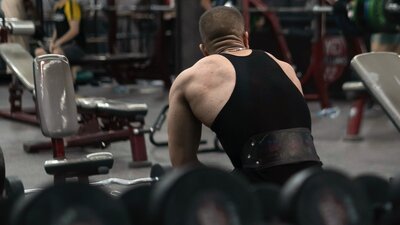Why The Belt?
The weightlifting belt is one of the most crucial pieces of equipment in heavy lifting. For competitors and amateurs alike, this can preserve the health of your spine while working with heavy loads. However, there’s more to it than just strapping it around your stomach and expecting heavier lifts. The belt has its time and a place in your workout. When used right, the belt can improve your performance in compound lifts and the strength of your core.
How to Use It
Generally speaking, the belt is put around the core and above the hip bones. The weightlifting belt will not be strapped in the same spot for everybody. It’s a piece of equipment that takes practice through trial and error in order to find how it can be most effective. For example, the deadlift mechanics may require a different height for the belt than the overhead press. What matters most is how it can be used to brace the body for compound muscle recruitment.
The most important muscles for the belt are in the core and the glutes. A lifting belt reduces spinal shrinkage during compound exercises. As a result, it can stabilize the lower back and glutes during functional loading (1). This is great for anyone who experiences low-back pain, because it is almost always caused by weak glutes and hamstrings.
The tightness of the belt takes practice too. Lifting with a belt requires different muscle recruitment in the core. Some athletes are trained to brace their core inwards while exercising. The belt requires outward flexion instead, as if the core is bracing for a gut punch. It’s important that the belt should not constrict air flow so it can brace the core outward. If lifters are using a belt for the first time, finding the proper buckle is the first learning curve that needs adjusting. There are some breathing techniques such as the Valsalva maneuver that help with this core engagement (2).
When to Use It
Belts are most effective during compound exercises in which one is one their feet. These exercises are also closed-chain movements which require abdominal pressure, hence the belt. They should not be worn for extension or supine movements. Belts come into use for barbell versions of the deadlift, squat, clean, snatch, and the overhead press. A lifting belt has especially been shown to have a positive effect on exertion in deadlifts (3).
Athletes participating in powerlifting can benefit from the belt. The sport involves moving weight from one point to another by any means. A belt can make the sport safer for its competitors. Lifters can benefit from the belt if performing around 80% or more of their one-rep max. Any lower weight may not call for one, unless a focus on breathwork is a desired practice. Lifters who compete in events should practice with one in order to maximize their numbers and prevent injury before the event.
Athletes with previous injuries in or around the spine can benefit from the belt as well. It can act as a safety net, assuring that lumbar extension is not excessive. However, if someone is only experiencing acute low-back pain, they should opt to improve their form mechanics before wearing a belt and increasing the weight. For both groups, warming up the core before exercising can be beneficial.
Belts should not be used during regular exercise. Some bodybuilders wear the belt in order to shrink their waist size, creating a V-taper before a show. This is not an optimal way to strengthen the core, especially for function.
Lastly, belts are not an excuse for weak abdominal muscles. They are a safety net for lifters working with heavy loads. If a stronger core is a personal goal, exercises for the core will show far more improvements. The belt is not a magical accessory for better abs, it’s a piece of equipment for physical activity.
Wrap-Up
Compound lifts are the core to a lifter’s routine. The belt ensures these lifters that they can improve the safety of these exercises while not impeding their gains. Not only will it minimize possible disadvantages, but it will improve the mechanics and results for lifters.
Works Cited

